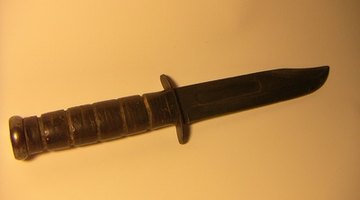How to Identify a KA-BAR Knife
Owning a KA-BAR knife can make the difference between having an average knife and possessing an iconic, historic all-in-one knife. The KA-BAR knife was named when a hunter, after his gun jammed, had to rely on a knife to "Kill-A-Bear," according to the knife's manufacturer. On Dec.

9, 1942, the knife became the official fighting knife of the United States Marine Corps; more than one million knifes were sold during World War II. Given its historical significance, identifying a KA-BAR knife can help you gain a new perspective on the past.
-
Look for the oval KA-BAR seal under the handle of the knife Underneath the KA-BAR seal is a "U.S.A" marking.
-
Check the knife for KA-BAR's famous oval-shaped leather handle. The handle is made of compressed leather washers layered over the tang, or handle extension. A butt cap holds the washers in place.
-
Flip the knife on its flat side and check for the "USMC" symbol on the leather handle of the knife. The symbol is located on the edge of the handle. If the knife was made for one of the other armed forces, it will be stamped accordingly.
The Drip Cap
- Owning a KA-BAR knife can make the difference between having an average knife and possessing an iconic, historic all-in-one knife.
- The handle is made of compressed leather washers layered over the tang, or handle extension.
- Flip the knife on its flat side and check for the "USMC" symbol on the leather handle of the knife.
References
Photo Credits
- knife army image by robert mobley from Fotolia.com
- knife army image by robert mobley from Fotolia.com
More Articles



